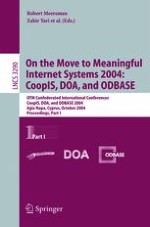sers: GADA, MOIS, WOSE, and INTEROP. We trust that their audiences will mutually productively and happily mingle with those of the main conferences. A special mention for 2004 is in order for the new Doctoral Symposium Workshop where three young post-doc researchers organized an original set-up and formula to bring PhD students together and allow them to submit their research proposals for selection. A limited number of the submissions and their approaches will be independently evaluated by a panel of senior experts at the conference, and presented by the students in front of a wider audience. These students also got free access to all other parts of the OTM program, and only paid a heavily discounted fee for the Doctoral Symposium itself (in fact their attendance is largely sponsored by the other participants!). If evaluated as s- cessful, it is the intention of the General Chairs to expand this model in future editionsoftheOTMconferencesandsodrawinanaudienceofyoungresearchers to the OnTheMove forum. All three main conferences and the associated workshops share the dist- buted aspects of modern computing systems, and the resulting application-pull created by the Internet and the so-called Semantic Web.
